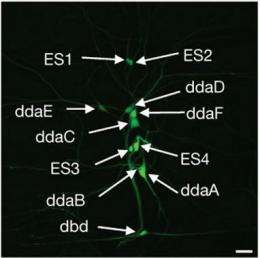Light activates class IV dendritic arborization neurons. Pre-stimulation image showing larval dorsal cluster sensory neurons. Image credit: Nature, doi:10.1038/nature09576
(PhysOrg.com) -- New research in the U.S. has discovered that fruit fly larvae have a series of photoreceptors covering the body that can detect light even when their primitive "eyes" are covered or removed.
The ability to sense light is important for fruit fly larvae because they burrow into rotting fruit, covering their rudimentary eyes (known as Bolwig organs) on their heads as they do so. If their entire body is buried in the fruit there is less chance of predation, and so having a way of detecting light alerts them to the fact the body is exposed and therefore vulnerable. Young larvae can also die if exposed to bright light for too long.
The researchers, Yang Xian and colleagues from the University of California at San Franciso, New York University and the Janelia Farm Research Campus in Virginia, compared the reactions to light of intact wild-type fruit flies (Drosophila melanogaster) and those with non-functioning Bolwig organs.
Their results showed both groups of larvae moved away from light at intensities of 0.57 mW mm-2 or higher, but at lower light intensities those lacking Bolwig organs were less sensitive to the light. (A typical bright sunny day represents light intensity of around 1 mW mm-2.) Both groups of larvae were highly sensitive to short wavelengths (blue, violet and ultraviolet) and less sensitive to longer wavelengths (red and green).
This movie shows photoavoidance of a wt larva to the light spot of 0.57 mW/mm2. Video: Nature, doi:10.1038/nature09576
The scientists identified the mechanism by which the larvae detect light, which is a network of neurons of a type called class IV dendritic arborization neurons covering the larva’s body. They tagged the neurons with a fluorescent molecule that glows green in the presence of calcium, which is released when the neurons fire, and this made the network visible when a light was shone on the larvae. They found the neurons were sensitive to light even when dissected from the larvae, and no other factors such as touch, temperature or reactive oxygen concentrations are involved.
The report, published in the journal Nature concludes that in dim light the Bolwig organs are the primary light sensors but in bright light the array of neurons becomes the main light sensing mechanism. The authors said further research is needed to reveal the molecular mechanism that enables the neurons to respond to light, and to find out if any other animals use a similar network of photoreceptors.
More information: Light-avoidance-mediating photoreceptors tile the Drosophila larval body wall, Nature advance online publication 10 November 2010. doi:10.1038/nature09576
© 2010 PhysOrg.com




















